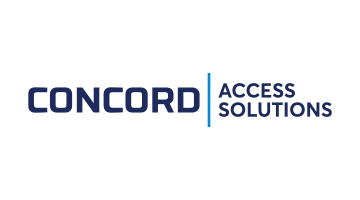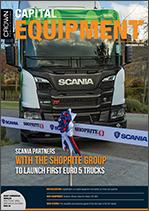 Scania partners with the Shoprite Group to launch first Euro 5 trucks
Scania partners with the Shoprite Group to launch first Euro 5 trucks
On the cover: Sustainable transport solutions that drive customer profitability are the driving force behind Scania Southern Africa’s partnership with the Shoprite Group, which has acquired over 100 of Scania’s New Generation trucks powered by Euro 5 engines.
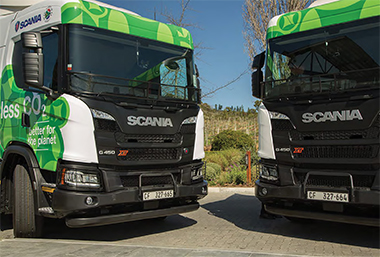 Speaking during the handover ceremony in Stellenbosch, Western Cape, Scania Southern Africa managing director Erik Bergvall noted Scania’s and Shoprite’s shared commitment to the development of sustainable transport solutions. “We were delighted to see how aligned the Shoprite Group is to Scania’s sustainability objectives. Shoprite is focused on reducing fuel consumption and the use of natural resources, very much in line with our own efficiency commitments.” He says Scania does not view the sale of the Euro 5 trucks to Shoprite as a transaction but rather as a long-term partnership during which the two companies can tackle environmental impacts by creating lasting value and transformation in the southern African transport landscape together.
Speaking during the handover ceremony in Stellenbosch, Western Cape, Scania Southern Africa managing director Erik Bergvall noted Scania’s and Shoprite’s shared commitment to the development of sustainable transport solutions. “We were delighted to see how aligned the Shoprite Group is to Scania’s sustainability objectives. Shoprite is focused on reducing fuel consumption and the use of natural resources, very much in line with our own efficiency commitments.” He says Scania does not view the sale of the Euro 5 trucks to Shoprite as a transaction but rather as a long-term partnership during which the two companies can tackle environmental impacts by creating lasting value and transformation in the southern African transport landscape together.
“The most important thing we do at Scania is to drive the shift towards a sustainable transport system. We see ourselves as leaders in this field, and we strongly believe that sustainability and profitability go hand in hand,” he says.
Although Shoprite and Scania are two different companies operating in very different industries at face value, both share a commitment to driving sustainability on all fronts.
Another platform that brings Shoprite and Scania together with many of the world’s sustainability advocates is the United Nation’s Sustainable Development Goals. Two of the first 111 Scania Euro 5 G450 A6x4 truck tractors purchased by the Shoprite Group. Scania partners with the Shoprite Group to launch first Euro 5 trucks Scania was the first major heavy commercial vehicle manufacturer to commit to these sustainability goals, and to achieving the Paris Agreement targets of limiting global warming to 1,5°C above pre-industrial levels.
Another platform that brings Shoprite and Scania together with many of the world’s sustainability advocates is the United Nation’s Sustainable Development Goals.
Scania was the first major heavy commercial vehicle manufacturer to commit to these sustainability goals, and to achieving the Paris Agreement targets of limiting global warming to 1,5°C above pre-industrial levels.
Digitalisation on capital equipment and safety at mines and quarries
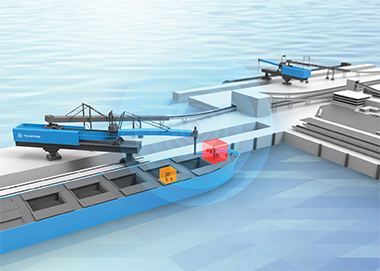 Digitalisation on capital equipment improves safety at mines and quarries. This feature highlights some of the digital technologies found on capital equipment today, explores how digitalisation on equipment improves safety, and takes a look at the uptake of these technologies in the mining industry.
Digitalisation on capital equipment improves safety at mines and quarries. This feature highlights some of the digital technologies found on capital equipment today, explores how digitalisation on equipment improves safety, and takes a look at the uptake of these technologies in the mining industry.
According to Willem Odendal, sales manager at Unisource, examples of how digital technologies improve safety on mines include automation and autonomous vehicles.
“Autonomous mining vehicles have been around for decades now and have been used to increase mining safety,” he says. “Autonomous mining equipment works through the integration of robotic components, advanced software, GPS, and internet connectivity. When combined, these elements allow operators to control heavy machinery and other gear from a safe point above the earth’s surface.”
He says biometric devices are being used, as well as touchless access control workforce management for mine security.
“Regardless of what your business procedures are or where you’re located, your mining operation has several unique requirements to ensure the highest productivity and, at the same time, the safety of your workers.” He says the security system needs to ensure that workers can access their assigned shifts and get to work on time.
Benefits of high-performance screen media
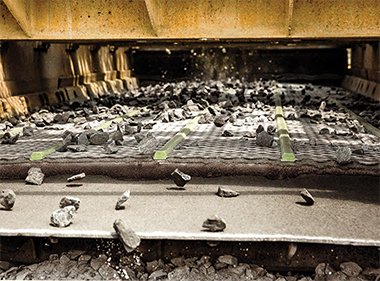 Choosing screen media for a screen box isn’t as simple as it used to be. What once was just woven wire now includes a variety of alternative options, such as rubber, polyurethane, metal plates, high vibration wire, combinations of different materials and more.
Choosing screen media for a screen box isn’t as simple as it used to be. What once was just woven wire now includes a variety of alternative options, such as rubber, polyurethane, metal plates, high vibration wire, combinations of different materials and more.
With each type comes countless new options for customisations of a screen deck to provide enhanced efficiency and throughput – whether by using one type of media or blending multiple media.
Standard woven wire is often the cheapest option at first sight, but that’s no reason for these alternative options to be passed over without careful consideration. Depending on the application, these innovative products can improve wear life; reduce pegging and blinding; speed up the stratification process and better remove fines, increasing the overall quality of the screened product.
Following are a few reasons to consider high performance screen media.
Southern African debut for Astec’s SX-6EX
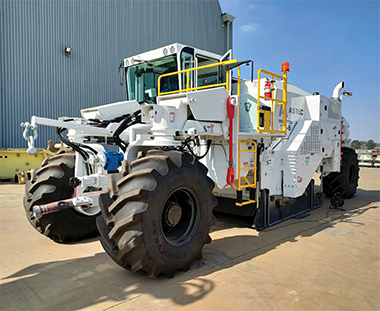 As part of its product expansion programme, driven under the OneASTEC business model, Astec Africa Middle East is launching the Roadtec SX-6EX, marking the company’s first foray into the southern African soil stabiliser/reclaimer market.
As part of its product expansion programme, driven under the OneASTEC business model, Astec Africa Middle East is launching the Roadtec SX-6EX, marking the company’s first foray into the southern African soil stabiliser/reclaimer market.
In September 2021, Astec Industries announced a major global restructuring of its business model, dubbed OneASTEC. Under the previous structure, 16 companies operated independently across a range of different market segments. OneASTEC therefore ushered in a new era for the company, with all the brands coming together under common operating systems across the entire business.
“Our company is ‘Built to Connect’ – that’s our purpose. We are committed to connecting people, processes and products, as well as advancing innovative solutions from rock to road. OneASTEC helps us achieve that purpose,” explains Johan Goosen, regional MD – Africa Middle East at Astec Industries.
As part of the restructure, Astec Africa Middle East (AME) has embarked on a product expansion programme across all market segments. One area where this is taking priority is the Infrastructure and Process Solution division, where a number of products that were previously not available to the local market are being rolled out.
The latest to find its way to the southern Africa market is the Roadtec SX-6EX soil stabiliser/reclaimer, which marks Astec AME’s grand entrance into the soil stabiliser/reclaimer market. The first unit has already arrived in South Africa, with more expected in due course, confirms Calvin Fennell, regional sales director Infrastructure Solutions, Astec AME.
The versatility and enduring appeal of the skid steer in the SA market
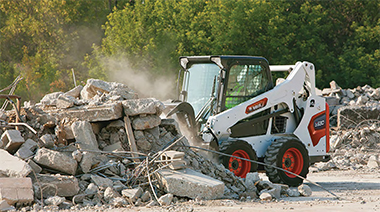 Skid steers are arguably the most popular compact construction machines on any job site due to their versatility, compact size, manoeuvrability, ease of operation, competitive pricing and the vast array of attachments that they can use. This feature takes a look at the size of the market for these machines, their applications, and ranges available in the local marketplace.
Skid steers are arguably the most popular compact construction machines on any job site due to their versatility, compact size, manoeuvrability, ease of operation, competitive pricing and the vast array of attachments that they can use. This feature takes a look at the size of the market for these machines, their applications, and ranges available in the local marketplace.
In recent years, Skid steer loaders have become commonplace in a multitude of industries within the diverse South African market, says Keon Kardolus, national sales manager (EMC) at ELB Equipment. This, he says, can mainly be attributed to features such as compact size, lifting capacity and manoeuvrability.
“In addition, customers are finding that skid steers are often a good investment over more expensive, single-purpose equipment.” He says part of the reason for the growth of skid steer loaders is their versatility.
“We find that we are selling these machines into new and exciting applications because of the extensive range of attachments being developed for skid steer loaders – most of these attachments are hydraulically driven which adds to their appeal.”
Warren Alexander, branch manager Isando at CASE Construction SA, agrees, saying that skid steers are among the most popular compact construction machines found at job sites due to their versatility, ease of operation, ability to tackle a wide range of jobs, and their low cost compared to larger machinery.
Volvo Trucks’ safety DNA leads to innovation
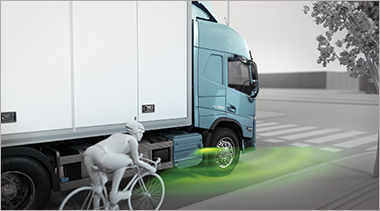 Some would argue that Volvo is synonymous with the word safety. Safety is built into the brand’s heritage, and it is a central part of the company’s identity.
Some would argue that Volvo is synonymous with the word safety. Safety is built into the brand’s heritage, and it is a central part of the company’s identity.
“We innovate and produce solutions that prevent accidents from happening – and reduce the consequences if an accident does occur,” said Waldemar Christensen, MD of Volvo Trucks South Africa. “In addition to making our trucks as safe as possible, we promote safe driving and raise awareness about traffic safety.”
Decades of safety research Since 1969, the Volvo Trucks accident research team has compiled and analysed data about accidents involving their vehicles. These results provide valuable input when creating trucks for the future.
Globally, more than 1,3-million people die each year in road accidents. Aiming for safety for all road users is crucial if these numbers are to be reduced.
“We look at safety from different perspectives, inside as well as outside the truck. It’s this approach that enables us to create systems that go beyond what’s required by authorities. And it guides us towards our vision of zero accidents with Volvo trucks,” says Christensen.
Emerging trends in business insurance
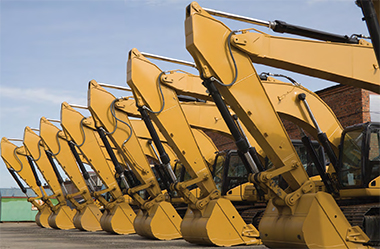 By nature, the business of insurance entails defining, evaluating and mitigating risk. For better risk mitigation in such a complex and ever evolving environment, insurers are increasingly adopting a customer-centric approach in order to provide solutions which speak directly to customer needs.
By nature, the business of insurance entails defining, evaluating and mitigating risk. For better risk mitigation in such a complex and ever evolving environment, insurers are increasingly adopting a customer-centric approach in order to provide solutions which speak directly to customer needs.
According to Jason Mellow, MiWay head of Business Insurance, clients are increasingly looking for products that are easy to understand and suited to their unique business requirements.
Clients also want to choose how they purchase and consume business insurance products. As an example, some clients prefer telephonic quotations and sales, while others prefer a more personalised face-to-face or broker experience. Insurers, urges Mellow, should be able to tailor their services to meet clients where they are at, not only in terms of their personal, but also their business journey.
“At MiWay, emerging trends are the drivers behind the products we design and continue to offer the local market. And we go to great lengths to ensure that our policies are presented with simplified wording that is less ‘insurance-speak’ and more ‘people-speak’. What I mean by this is that our products and services, including the way in which we talk about them, are all about the person’s experience of business and the world in their everyday lives,” says Mellow.
He adds that when you talk to clients about “their assets rather than the equipment they need to protect to sustain their business, it’s a language they understand”. In this way, he adds, clients have the freedom to choose products that speak to their individual business, without the pressure of paying premiums for services they may not need.
Five trends that are shaping the future of SA’s fleet management
The future has never been more exciting. New technologies continue to shape the connected world, enabling us to communicate virtually, work remotely, and even access telehealth.
Similar innovations are shaping South Africa’s fleet management industry, driving the adoption of electric vehicles, Mobility-as-a-Service (MaaS), and countless other cutting-edge trends enabling the sector to operate efficiently, safely, and more environmentally friendly.
“Although technology like The Internet of Things (IoT), MaaS, and Artificial Intelligence (AI), has been around for some time now, the last two years accelerated its adoption, ”says Justin Manson, sales director at Webfleet. “Fleet managers have been able to use this technology to improve the customer experience, optimising transportation and creating opportunities to monitor their vehicles better. And this trend will only expand over the coming years.”
Internet-connected devices are everywhere, from smart watches to smart home appliances, and the list of devices continues to grow. The Ericsson Mobility report estimates that there will be around 29-billion connected devices this year and that IoT will power approximately 18-billion of them.
The Internet of Things is critical in fleet operations, such as vehicle tracking, tyre pressure monitoring, and refrigerated monitoring systems. However, this technology will play an even more prominent role in the future of transportation, where fleet managers and drivers can monitor vehicle conditions in real time, accurately route vehicles to different lanes to minimise traffic time, and enhance automated alerts. For example, the technology will let fleet managers and drivers know what’s about to break down or proactively alert emergency services and operators if a driver enters a danger zone, creating strategic alternatives to reroute and safeguard drivers and cargo.





